Stone processing is included in the list of the most popular operations in construction and production. Stone products in one form or another may be required both as a full-fledged building material, and as raw materials, on the basis of which new products are obtained. The simplest processing operation is cutting. It allows you to get a blank of certain parameters, and in some cases also make adjustments to the faces. To perform such tasks, a stone cutting machine is used, which has special elements of mechanical impact. It does not have to be a bulky high power machine. Modern manufacturers offer units and small sizes that can be operated in a home workshop.
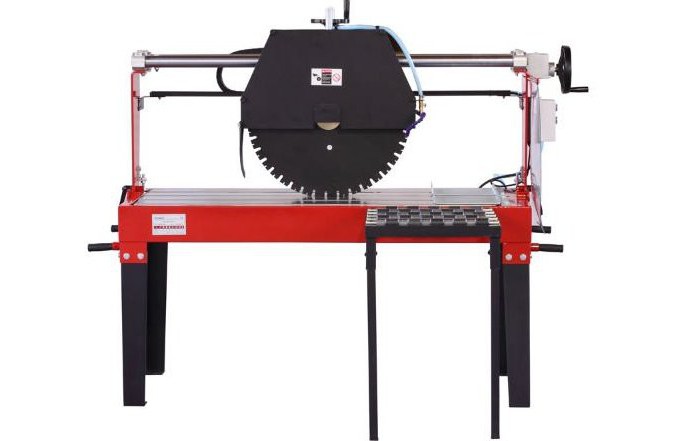
What is a stone machine?
The basis of the structure is formed by the bed, on the basis of which the working operations take place. As a rule, this is an all-metal platform into which a group of guides and a directly cutting organ are embedded - most often a cutting disc made on the basis of diamond segments. The mechanisms are driven by carriages and rollers. Their arrangement may vary, causing, among other things, the principle of interaction between the workpiece and the cutting element. Either the processed stone is translationally moving, allowing the disk to perform processing, or, on the contrary, with a cut, the circle changes position relative to the target material.
The source of energy, which ultimately transmits the force to the working body, can be both mechanical drives and an electric motor. Actually, the ability of the unit to cope with certain workpieces will largely depend on the type of drive. The simplest stone cutting machine can only work with thin plates or materials with a pliable structure. Large-format machines, in turn, successfully and in streaming mode cope with solid-state granite, marble and other rocks that are quite difficult to process.
Types of machines
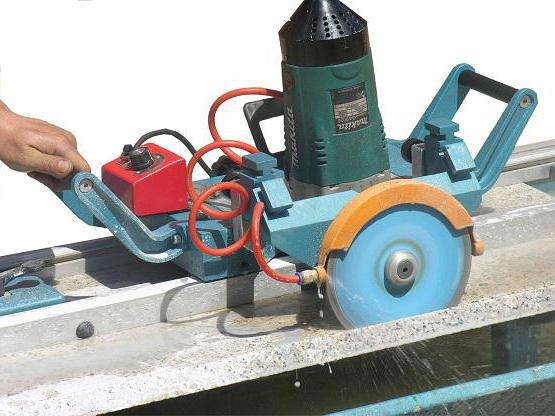
The main classification has already been identified - this is the type of drive. We can distinguish small manual machines and electric machines. The former are more likely to work with porcelain tile. They consist of a small platform, rails and a diamond-cutter. A feature of such models is the ability to work in conditions of complete autonomy, since the user himself will act as a source of energy by pressing the handle. Electric models are characterized by a more massive base, provided with an electric drive and a diamond disk, which is installed stationary. This is an optimal machine for cutting tiles and stone, which not only provides high mechanical stress, but also has a precision machining. However, the quality and overall cutting capabilities depend on specific characteristics.
Performance data
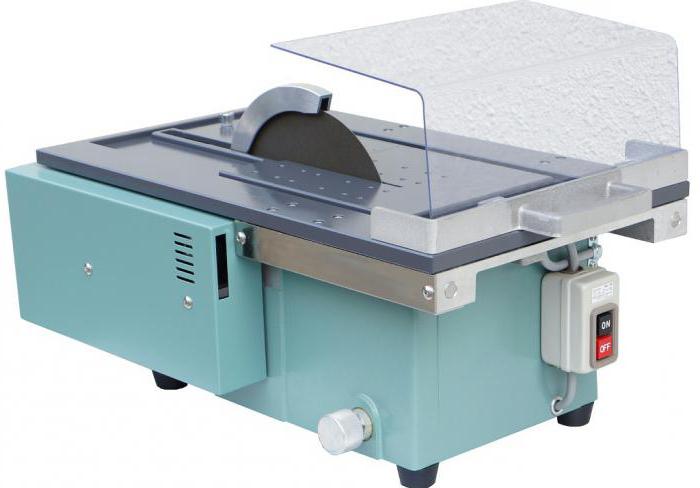
Performance and basic parameters are most often associated with each other. One should start from the dimensions of the bed - its length, which can be 30-60 cm on average. This parameter will ultimately determine the ability to work with oblong stones and tile products of various formats. Usually, the range of sizes of the disk that will carry out the cutting follows from the characteristics of the bed. The diameter of the circle varies from 11.5 to 40 cm. Masters select disks based on the size of the mounting hole - an average of 1-3 cm.In addition to the structural characteristics, a stone cutting machine is also evaluated by its power potential, when it comes to electric machines. Roughly speaking, household machines with an electric motor can have a power of 700-800 watts. This is enough for working with ceramics, tiled products and glass. However, for the same large-sized granite, at least 2200-watt aggregate will be required. With such a potential, it will be possible to cope with blanks with a thickness of the order of 10 cm.
Consumables and accessories

The main consumable is a disc cut. There are simple and segmented circles, both specialized and universal. Simple models are designed for ultra-precise and accurate cuts - for example, when working with tiles or ceramics. The segmented stone cutting disc is characterized by increased hardness, wear resistance and corresponding cutting ability. The intermittent diamond cutting edge allows it to process both solid minerals and concrete, but the result is a rough cut that requires grinding. As for accessories for the machine, in this category are listed: guide modules, carriages, cabinets and stands, niches for consumables, etc.
Features of industrial machines
Such models initially provide for high power and advanced capabilities for working with different materials. For example, the depth of cut can exceed 10 cm, and the cut length is 100 cm. In some versions, industrial stone cutting machines also carry out cutting at an angle from 45 to 90 °. This feature provides a special tool design for controlling the cutter.

A distinctive feature of industrial models can be called the presence of high-tech security systems, since heavy loads contribute to the appearance of risks of damage during operation. For example, to work with large volumes, experts recommend a stone cutting machine with a water supply that has a cooling effect. The pump is responsible for this function, directing the flows of cold liquid to the working area.
Manufacturers and prices
The foreign segment for stone machines is represented by Fubag, Stayer, Diam, Bosch and DeWALT. Domestic products are presented on the market under the brands Caliber, Zubr, Enkor, etc. The difference between the models from both groups is expressed in the technological level, reliability of the design, and price. The first two qualities are dominated by imported units, and Russian machines win at the expense of attractive cost. For example, the Diam stone-cutting machine in the ML-1200 modification is estimated at 40 thousand rubles, while offering high power and wide possibilities for adjusting the cut. As for domestic models, among them you can find machines for 5-10 thousand, but it is obvious that they will lose both in power potential and in sets of functions.
Nuances of equipment operation
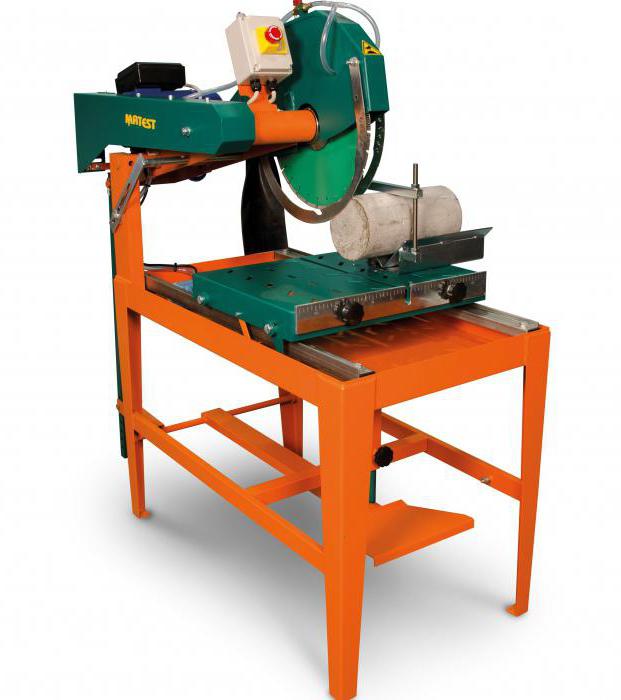
Before starting work, the operator inspects all components and components of the machine for serviceability. Separately, electrical connections, mounts and platform stability are checked. Next, the appropriate drive is selected for work tasks. The cutting element should not only fit the size, but also be solid and not have signs of obvious deterioration. This concerns safety issues. By the way, the user himself begins to work in a special apron, glasses and construction headphones. If necessary, if there is no instant dust extraction system, the operator also puts on a respirator. Now you can start the cutting procedure. Processing is carried out in a smooth mode until the completion of cutting. The role of the operator is to control the mechanical equipment, which regulates the process of interaction between the disk and the workpiece. After the operation is completed, the machine is turned off, and all its parts are again checked for serviceability.
Conclusion
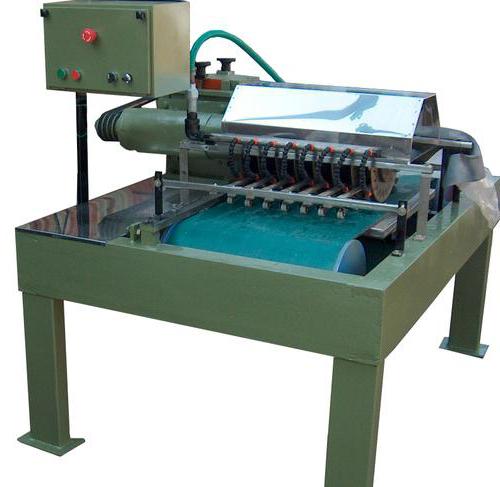
Stone cutting can be done in many ways.Traditional machine tools with disks offer a balanced method that does not require unnecessary costs and special organization of the process. A standard electric stone cutting machine will find its place both on the construction site and in the workshop of a small manufacturer. However, large factories and jewelry enterprises have long been using more advanced thermal and waterjet machines for cutting solid materials. They allow you to get a high-precision cut for a short time period, but, on the other hand, are much more expensive and are difficult to organize the process.








